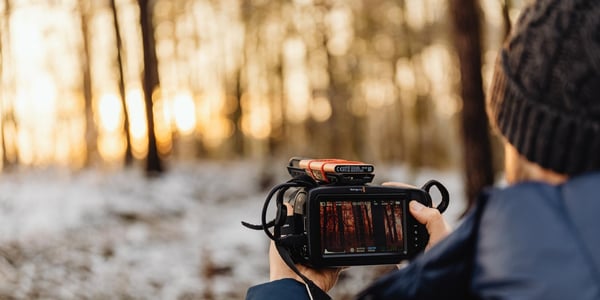Sheltering in place because of COVID-19 can provide an opportunity to finally catalog those years...
15 Smartphone Photography Tips: How to Take Better Photos with Your Phone
Smartphone photography has come a long way, transforming everyday phone users into amateur photographers. With increasingly powerful cameras in our pockets, we have the potential to capture stunning photos at any moment. A few simple tips can elevate your photography, whether you're snapping pictures of your family, a breathtaking landscape, or a plate of food. In this blog, we’ll walk you through practical tips to improve your smartphone photography, ensuring you get the most out of your phone's camera.
1. Understand Your Camera's Settings
Smartphone cameras come equipped with various settings that can significantly enhance your photos. Understanding how these features work is the first step to improving your photography.
Resolution and Quality
Always set your camera to the highest resolution. Higher quality means more detail in your photos and gives you more room to crop or edit later without losing quality.
HDR Mode
HDR (High Dynamic Range) balances light and shadow in high-contrast scenes, such as sunsets or backlit subjects.
Grid Lines
Turn on grid lines in your camera settings to help with the rule of thirds, making it easier to align your subject and create more balanced compositions.
2. Pay Attention to Lighting
Lighting is one of the most critical elements of photography. The quality and direction of light can make or break a photo.
Natural Light
Whenever possible, use natural light. Photos taken in natural light look more vibrant and precise than those shot in artificial light. Try to avoid harsh midday sunlight, which can cast unflattering shadows. Early morning or late afternoon, also known as "golden hour," provides softer, more flattering light.
Artificial Light
If you're indoors or shooting at night, avoid your camera's flash, which can make photos look flat and washed out. Instead, find a source of indirect light, like a lamp or streetlight, and position your subject near it.
Backlighting
Shooting against the light (with the light source behind your subject) can create silhouettes or dramatic effects, but it requires careful exposure adjustment. Tap the screen where your subject is to lock the focus and adjust the brightness as needed.
3. Focus and Exposure Control
Many people snap photos without adjusting focus or exposure, but taking a moment to fine-tune these settings can dramatically improve your photos.
Manual Focus
Most smartphones let you control the focus by tapping on the screen. Always make sure the subject of your photo is in sharp focus. This is especially important for close-up shots.
Adjust Exposure
After selecting your focus, most phones allow you to adjust exposure by sliding your finger up or down on the screen. Brighten or darken the image based on the lighting conditions and your creative goals.
4. Composition Matters
Good composition can take an ordinary photo and make it extraordinary. How elements are arranged in the frame can add interest and guide the viewer’s eye to the subject.
The Rule of Thirds
As mentioned earlier, turning on the grid lines can help you apply the rule of thirds. This technique involves placing the critical elements of your photo along the lines or at the intersections of the grid rather than in the center of the frame. This tends to create a more dynamic and visually appealing image.
Leading Lines
Use natural lines, like roads, bridges, or rivers, to draw the viewer’s eye into the image. Leading lines can create a sense of depth and movement in your photo.
Frame Your Subject
Look for ways to frame your subject using surrounding objects, such as archways, trees, or windows. This can help highlight the subject and add layers to your photo.
Negative Space
Don’t be afraid to leave some areas of your photo empty. Negative space can help emphasize the subject and make the composition seem less cluttered.
5. Use Different Angles
Changing your perspective can add an interesting twist to an otherwise straightforward shot.
Low Angle
Shooting from a low angle can make your subject appear more powerful or grand. It’s also great for adding drama to landscape photos.
High Angle
Shooting from above can provide a unique perspective on your subject, whether it’s a crowd of people, a flat lay of objects, or a sprawling landscape.
Tilted Angle (Dutch Angle)
Experimenting with a slight tilt can add a sense of motion or energy to your photos, but be careful not to overuse it. This angle works best when you’re aiming for a dynamic, creative shot.
6. Take Advantage of Editing Tools
One of the advantages of smartphone photography is the ease of editing. Most smartphones have built-in editing tools that can drastically improve the final result.
Basic Adjustments
Start by adjusting brightness, contrast, and saturation to enhance the overall look of your photo. Increasing the contrast can make colors pop while lowering saturation can give your image a softer, more muted feel.
Cropping
If your composition isn’t perfect, you can always crop the image afterward to improve it. Cropping can help you focus on the subject and remove distracting elements from the background.
Filters
Filters can dramatically change the mood of your photo. However, try not to rely too heavily on them. Instead, use filters sparingly to complement the image rather than overpower it.
Click here or the button below to download our 50+ Travel: The Why, Where, and How eBook!
7. Keep Your Lens Clean
It might sound obvious, but a dirty lens can result in blurry or hazy photos. The camera lens can easily accumulate smudges since smartphones are constantly in our hands, pockets, or bags. Before snapping a picture, take a second to clean the lens with a soft cloth or the edge of your shirt.
8. Use Burst Mode for Action Shots
If you’re photographing something in motion, like kids playing or birds flying, use burst mode to capture a series of shots in quick succession. This increases your chances of getting that perfect moment. Once you’ve taken the burst, go through the images and choose the best one, deleting the rest to save space.
9. Experiment with Portrait Mode
Many smartphones now have portrait mode, miming the shallow depth of field effect typically seen in professional cameras. This feature blurs the background, helping your subject stand out. Use portrait mode when taking pictures of people, pets, or any subject you want to highlight against a less important background.
10. Use Third-Party Apps for More Control
If you want more control over your smartphone’s camera settings, consider downloading third-party camera apps. These apps often offer additional features like manual ISO control, shutter speed adjustment, and advanced focus tools, giving you even greater creative flexibility.
- ProCamera (iOS) and Camera FV-5 (Android) are two apps that provide a more DSLR-like experience on your phone.
- For editing, apps like Snapseed and Adobe Lightroom offer advanced editing tools to fine-tune your photos after shooting.
11. Practice Patience
Sometimes, the perfect shot doesn’t happen immediately. Be patient and wait for the right moment, especially when dealing with changing light, movement, or dynamic scenes. Whether capturing a sunset at its peak or waiting for the perfect expression on someone’s face, a little patience can go a long way.
12. Try Night Mode
If your phone has a night mode feature, don’t hesitate to use it in low-light conditions. Night mode uses longer exposure times and advanced processing to capture clearer, more detailed images in dark environments. Keep your hands steady or use a tripod for the best results, as longer exposure times can lead to blur if the camera moves.
13. Use a Tripod or Stabilizer
For extra stability, especially in low light or when shooting video, consider using a tripod or stabilizer for your phone. Even a small, portable tripod can make a big difference in the sharpness of your photos.
14. Don’t Zoom In—Move Closer
Using digital zoom on your smartphone camera can produce pixelated, low-quality images. Instead of zooming in, physically move closer to your subject. If moving closer isn’t possible, you can always crop the image later during editing without sacrificing too much quality.
15. Take Photos Regularly
Finally, practice makes perfect. The more you experiment and take photos, the better your skills will become. Try taking pictures in different lighting conditions, at various angles, and of different subjects. Over time, you’ll develop a stronger sense of composition, lighting, and timing.
Click here or the button below to subscribe to our blog!







